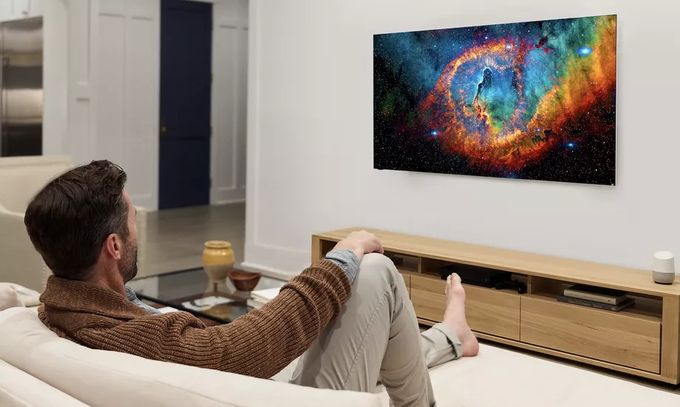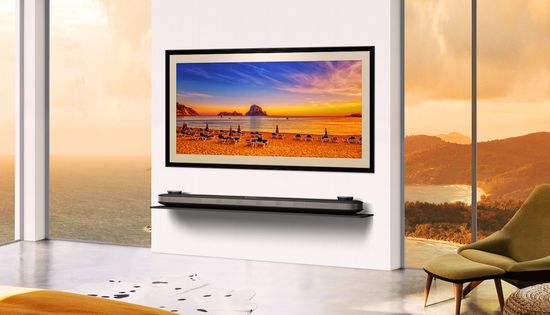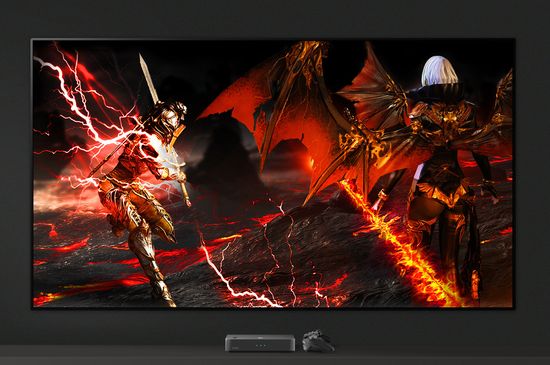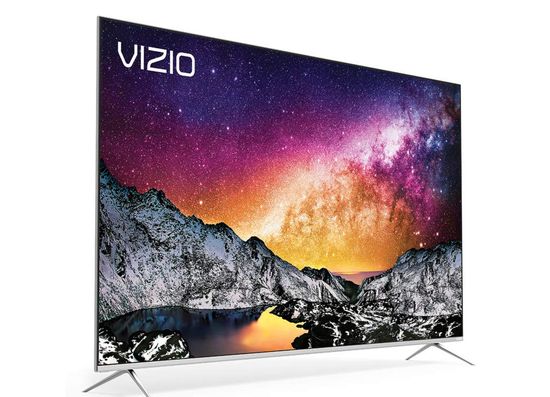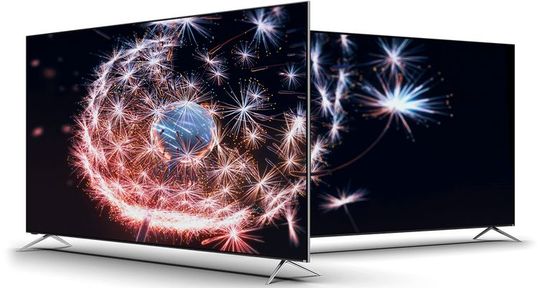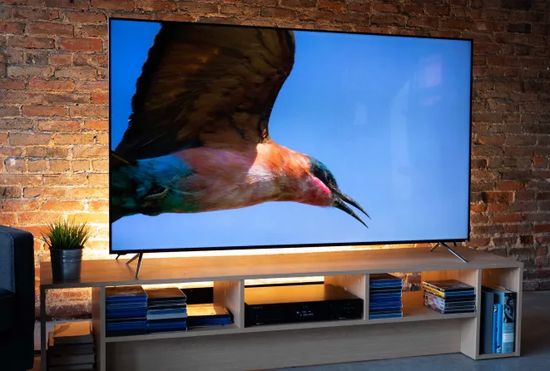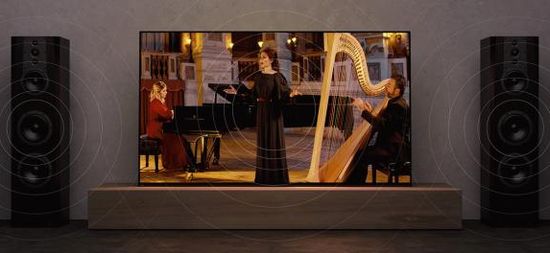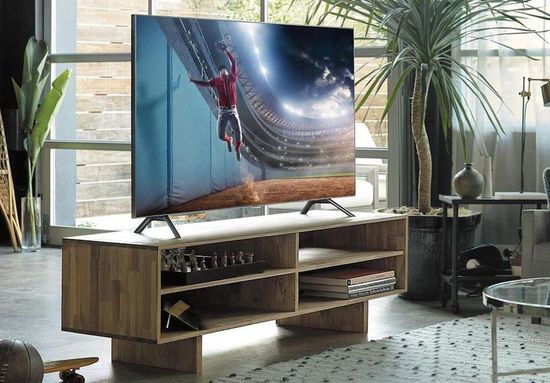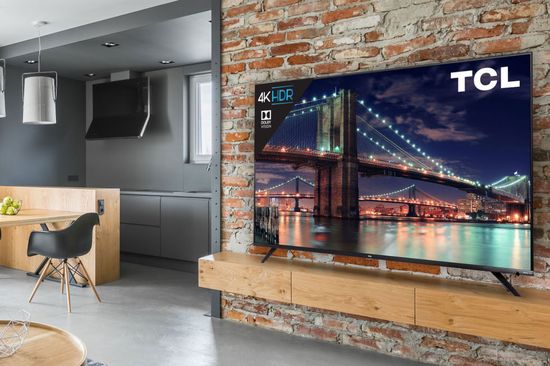This review is updated regularly with new models
Last updated: September 15, 2019
As known, the huge competition in the consumer electronics segment encourages companies to constantly improve their products, annually offering new models. Of course, this trend is most clearly manifested among complex household appliances, including TVs, PCs, projectors, etc. As a result, in recent years, the structure of competition has changed and expanded. The TVs segment perfectly illustrates this aspect.
With some assumptions, it includes:
– competition between technologies, for example, OLED vs LED (including QLED and Nano Cell) TVs;
– competition between brends and companies.
Of course, most companies focus their efforts on improving one or two technologies (Samsung – QLED, LG – OLED & Nano Cell). But market leaders usually offer models in every direction.
– competition between the most successful models over the past few years. The expansion of functionality through the use of innovation does not always compensate for the decrease in prices for previous models.
As a result, the TOP lists of many experts simultaneously contain new innovative models and the most successful models of previous years.
In addition, they often do not coincide with Best Sellers, the list of which depends significantly on price, advertising and customer reviews.
Of course, such a variety pleases consumers, providing comprehensive and dynamic development in this segment, but sometimes it significantly complicates the choice of the optimal TV.
In 2019, experts most often include the following models in their TOP lists:
– LG C9 (2019);
– Vizio P-Series Quantum X (2019), Vizio P-Series Quantum (2018), Vizio P-Series (2018);
– Sony A9F Master Series (2018);
– Samsung Q8FN (2018);
– TCL 6 Series (2018)
LG C9
LG C9 once again confirms the dominance of LG’s OLED TVs over OLED models of other companies. In 2017, the LG C7 was one of the best OLED TV. As known, according to most experts, the LG C8 was the best 4K OLED model of the 2018. This year, LG introduced the LG C9, which became its improved version (C9 vs C8.) Deja vu! Again, the LG 4K OLED model claims to be a leader among OLED TVs from other companies.
Today, the C9 is one of the most affordable OLED models with excellent specs and all the pros of this technology, including unlimited contrast and ultra-wide viewing angles. Of course, today the market offers gorgeous 4K HDR models with LED backlight. But exceptional performance allows the C9 to successfully compete with them.
TV supports gallery mode with magnificent landscapes from the TripAdvisor portal, additionally performing a decorative function in the living room.
In addition, the powerful 2nd Gen α9 Processor provides almost instant response up to 1 ms, Input lag up to 12.9 ms, and efficient operation of VRR and ALLM options with HDMI 2.1 support. As a result, the model ensures excellent graphics in the most demanding modern games. Combined with virtual surround sound in 5.1 format and unlimited contrast, the C9 is great as a gaming console.
The company offers the model in three versions, including:
– 55-inch LG OLED55C9PUA;
– 65-inch LG OLED65C9PUA;
– 77-inch LG OLED77C9PUA.
4x HDMI 2.1 (1x ARC), 3x USB 2.0, component, LAN ethernet port, RF input and optical audio output provides excellent connectivity.
Key features
Main specs:
– 4K (3,840 x 2,160) resolution;
– HDR (High Dynamic Range) support, including HDR10, Dolby Vision, and Dolby Atmos standards;
– native 120 Hz refresh rate;
– LG webOS smart platform;
– DCI-P3/10-bit color space;
– LG ThinQ AI functionality (with Alexa and Google Assistant);
– 2nd Gen α9 Processor.
Performance Data from reputable reviewed.com demonstrate:
– HDR contrast (brightness/black level): 212.7 nits/0.002 nits;
– SDR contrast (brightness/black level): 266.3 nits/0.002 nits;
– HDR peak brightness: 714.6 nits (20%);
– HDR color gamut coverage: 97% (DCI-P3/10-bit);
– SDR color gamut coverage: 97% (Rec.709).
Of course, the peak HDR brightness of about 700-750 nits is a high value for OLED panel. As known, their brightness is significantly inferior to LCD LED Tvs.
The video at the end offers a side-by-side comparison of the LG C9 (2019) vs LG C8 (2018).
Vizio P-Series (2018), P-Series Quantum (2018), and P-Series Quantum X (2019)
Vizio TVs have long and successfully competed in the budget segment. But over the past few years, the company has introduced a line of TVs that successfully compete in the middle and even top range with recognized leaders. For example, today, many experts include Vizio P-Series (2018), Vizio P-Series Quantum (2018), and, of course, Vizio P-Series Quantum X (2019) in their TOP lists.
In fact, the Vizio P-Series (2018) can be considered the start of the transition of Vizio TVs to the upper segment. This series has improved specs compared to the Vizio P-Series (2017), including higher brightness, expanded color space, a better design, and more far-reaching smart features.
Testing in Calibrated Dark mode:
– SDR Black Level: 0.05 nits;
– SDR Reference Brightness: 195.10 nits;
– HDR Black Level: 0.08 nits;
– HDR Peak Brightness: 949.30;
– SDR Color Gamut coverage: 99%;
– HDR Color Gamut coverage: 93%.
Black:
– SDR 90% Black: 0.002 nits;
– SDR 10% Black: 0.06 nits;
– HDR 90% Black: 0.008 nits;
– HDR 10% Black: 0.099 nits.
The P-Series uses the Vizio Cast smart system. In fact, today it is an advanced Google Cast with additional elements from Vizio. In addition, TVs have pre-installed Netflix, YouTube and some other apps. Moreover, the P-Series is compatible with Alexa and Google Home, including integrated voice assistant.
Unfortunately, TVs have some disadvantages, which is normal for LED models in this segment. In particular, the display of black, including its depth and gradations, depends on the screen brightness. As known, each sub-pixel of an OLED panel emits its own light, in fact being a local zone. Therefore, OLED TVs do not have this problem.
Vizio P-Series Quantum (2018)
But the company did not limit itself to the Vizio P Series in 2018, introducing the magnificent Vizio P Quantum Series with Quantum Dots technology.
As known, it uses an additional panel with an LCD layer, providing unprecedented color saturation and color accuracy. As known, in recent years, Samsung has dominated in this segment. But then, LG has developed a similar technology called Nano Cell and for several years now has been offering Nano Cell TVs.
In 2018, Vizio fearlessly entered into competition with these reputable giants by offering the Vizio PQ65-F1 Quantum Tv. Today it can be bought for less than $ 1,200.
Key features:
– 4K (3,840 x 2,160) resolution;
– High Dynamic Range (HDR10 & Dolby Vision standards);
– Quantum Dot technology;
– FALD (full-array local dimming) LED backlights;
– 192 local dimming zones;
– SmartCast (Google cast) internet features;
– 120 Hz native refresh rates;
– Amazon Echo/Google Assistant compatible;
– free streaming TV.
Testing in calibrated mode:
– SDR Black Level: 0.06 nits;
– HDR Black Level: 0.15 nits;
– HDR Peak Brightness: 2,391 nits;
– SDR Reference Brightness: 350.40 nits;
– HDR Reference Brightness: 797.50 nits;
– HDR APLs: 2%–294.30, 10%–928.30, 20%–1,663, 40%–1,219, 50%–1,307 nits;
– SDR Color Gamut coverage: 99%;
– HDR Color Gamut coverage: 96%.
Black
– SDR 10% Black Box: 0.065 nits;
– SDR 90% Black Box: 0.004 nits;
– HDR 10% Black Box: 0.20 nits;
– HDR 90% Black Box: 0.01 nits.
– Viewing Angle: 59.95°.
Of course, it’s great for $ 1,200.
Vizio P-Series Quantum X
Inspired by the excellent result, in 2019 the company introduced its improved version called Vizio P-Series Quantum X.
Series Quantum X or PQX contains 65-inch and 75-inch TVs only:
– 65-inch Vizio PX65-G1;
– 75-inch Vizio PX75-G1.
Today, the cost of 65-inch model does not exceed $ 2,000.
65- and 75-inch versions use different amounts of local dimming zones. In particular, the 65-inch PQX has 384 total local dimming LED zones compared to 480 in the 75-inch PQX.
Accordingly, the 75-inch PQX provides higher performance. On the other hand, today both models can claim the status of brightest TVs, providing up to 3,000-nit peak brightness. For comparison, today HDR-capable TVs with 1,000-nit brightness levels are considered very bright.
Main specs have not changed much, except for an increase in the number of local dimming zones (384/480 vs 192), and support of HLG-standard for HDR.
Testing in Calibrated picture mode:
– HDR peak brightness: 2,057 nits (40% white);
– SDR peak brightness: 1,149 nits (40% white);
– HDR color gamut coverage: 95% (DCI-P3/10-bit);
– SDR color gamut coverage: 98% (Rec.709);
– viewing angle: ±12.78°.
Of course, their very high brightness provides excellent contrast. In addition, quantum dot display covers about 95% of the wide P3 color gamut. As a result, the 65-inch PQX delivers image quality that is comparable to the LG OLED C9. But LG’s popular flagship costs $ 1,000 more. Of course, a narrow viewing angle that cannot compete with the super-wide angles of OLED models, occasional light bloom, and not ideal Smart platform are still inferior to the leaders. But the very low price for this class with a margin compensates for all the shortcomings, providing these models with huge growth potential.
Sony A9F Master Series (2018)
Today, the premium TVs segment is characterized by two opposite trends. On the one hand, manufacturers reduce the cost of OLED matrices and, accordingly, OLED TVs. On the other hand, the image quality of 4K HDR LED models (including QLED or LG Nano Cell TVs) is rapidly approaching OLED level with a slight increase in price. It can be assumed that in the coming years the difference will practically disappear. However, today the border between them remains.
In fact, Sony remains one of the few companies that continues to compete with LG in the OLED TVs segment. In 2018, the company introduced the Sony A9F Master Series, which includes 55-inch and 65-inch Sony XBR55A9F / XBR65A9F BRAVIA OLED 4K HDR Tvs.
Key features:
– 4K resolution (3,840 x 2,160);
– High Dynamic Range compatibility (HDR10 and Dolby Vision);
– built-in Android smart platform;
– native 120 Hz refresh rate.
Testing in Cinema mode (ANSI checkerboard pattern):
– HDR contrast (brightness/black level): 308,1 nits/0,002 nits;
– SDR contrast (brightness/black level): 243,2 nits/0,002 nits;
– HDR peak brightness: 729,8 nits (10%);
– HDR color gamut coverage: 98% (DCI-P3/10-bit);
– SDR color gamut coverage: 100% (Rec.709);
– viewing angle: ±99.3°.
In addition to the traditional pros of OLED technology, including extra-wide viewing angles and unlimited contrast due to almost “0” black levels, A9F covers 98% of the extra-wide P3 color gamut, producing rich, luminous colors across the spectrum.
In addition, innovative Acoustic Surface Audio+ technology uses 3 actuators and 2 powerful subwoofers, providing excellent surround sound.
Moreover, TV uses the great Sony’s Android-based smart platform with Chromecast functionality, Google Play / Home / Assistant integration, etc. Unfortunately, the user interface and remote control menu are quite complex.
Samsung Q8FN (2018)
Of course, Samsung also does not reduce its activity. In 2018, the company introduced the great Q8 series, which includes:
– 55-inch QN55Q8FN ($ 1,300 – September 2019);
– 65-inch QN65Q8FN ($ 2,600 – September 2019);
– 75-inch QN75Q8FN ($ 3,500 – September 2019).
The series uses a minimalist design.
Traditionally, it competes with the eighth series of LG OLED 2018, which includes B8, C8, Е8, G8, and W8 series.
Main specs:
– 4K (3,840 x 2,160) resolution;
– High Dynamic Range (HDR10/HDR10+ standards);
– Samsung Smart Hub;
– FALD (full-array local dimming) LED backlight;
– Quantum Dot technology;
– OneRemote.
1080p content easily upscales to the native 4K resokution, but optimal setting requires Sharpness control.
Testing in Movie mode:
– SDR Contrast: 207.7 / 0.05 nits;
– SDR Gamut Coverage: 95%;
– HDR Contrast: 569.5 / 0.1 nits;
– HDR Benchmarks: 2%-98.09 / 10%-309 / 20%-1125 / 40%-1477 / 50%-1472 nits;
– Horizontal Viewing Angle: 19.82% / ±9.91°.
Unfortunately, the models retain the disadvantages of QLED technology, including relatively small viewing angles and the inconsistent black levels due to the operation features of FALD. In this case, the TV does not correctly display dark areas, increasing the black level.
HDR quality is better for bright rooms due to high brightness. Its HDR Black Levels is 0.11 nits for 10%, and 0.055 nits for 90%. But TV has an ambient light sensor that automatically reduces brightness in a very dim or dark room.
Today, this series quite successfully competes with the 8th series of LG OLED Tvs.
TCL 6 Series (2018)
TCL LED TVs with tremendous triumph first appeared in 2017. Chinese TCL Corporation proposed TVs with 4K resolution, HDR, a built-in Roku smart platform, and a fairly high picture quality for an amazingly low price. As a result, the popularity of these TVs has been growing rapidly for several years, and many TCL models have become Best Sellers. TCL 6 Series was no exception.
It includes a 55-inch TCL 55R617 (Best Buy) / 55R615 (Amazon) for a little over $ 500, and a 65-inch TCL 65R617 / 65R615 up to $ 1,000.
55- and 65-inch models have the same specs, except for the number of FALD (full-array local dimming) zones (96 and 120, respectively).
The R617 models cost $ 50 more because of the Roko remote with support voice commands.
Key features:
– 4K resolution (3,840 x 2,160);
– High Dynamic Range (HDR10 and Dolby Vision standards);
– built-in Roku streaming platform with Roku remote;
– FALD (full-array local dimming) LED backlight;
– native 60 Hz refresh rates.
Each TV has three HDMI 2.0-compatible inputs, a USB 2.0 input, ethernet (LAN) in, optical and headphone audio out, a splitter connection for shared component/composite input, and a coaxial jack for cable/antenna connection.
Testing in Movie mode showed SDR Contrast of 200 nits / 0.02 nits (brightness/black level) and SDR color gamut coverage of 97% (Rec. 709), and great local dimming.
In addition, these TVs provide excellent HDR content playback quality, providing peak brightness around 600 nits and covering around 93% of the DCI-P3 color gamut.
Input lag in Game mode does not exceed 18 ms, allowing you to use TV as a game console for not very demanding games.
Conclusions
Thus, today the market offers a wide selection of different TVs in all price segments. Traditionally, the most successful models of last year successfully compete with new products due to lower prices.
1. Sony and LG offer wonderful innovative Smart OLED 4K TVs. The Sony A9F Master Series (2018) costs from $ 3,000 and up, and the LG C9 PUA (2019) costs about $ 2,500 (prices for 65 inch models).
2. Samsung and Vizio offer the great QLED TVs. Samsung Q8FN (2018) costs up to $ 2,000, and Vizio P-Series Quantum X (2019) costs up to $ 1,700 (for a 65-inch models).
3. TCL offers 6 Series 4K HDR Smart LED TVs (2018) with excellent specs and high image quality for up to $ 1,000 only (65-inch model).
We sincerely wish you the Right Solution!
